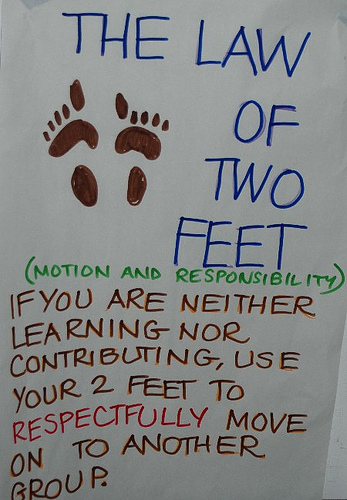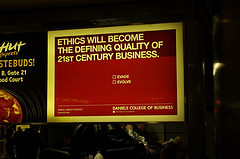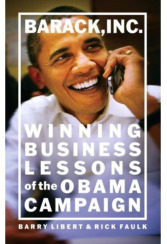|
|
|
Archive for the 'Group Dynamics' Category
Wednesday, July 1st, 2009

Now check out my other WW: How To NOT Learn
Your comments—priceless
Don’t miss a post, subscribe via RSS or EMAIL
Image credit: orcmid on flickr
Posted in Group Dynamics, Personal Development, Wordless Wednesday | 5 Comments »
Monday, May 18th, 2009
A few days ago a CEO mentioned that he tries to run his company based on the Golden Rule. He was surprised when I responded that that wasn’t always a good idea and wanted to know why I thought that.
 Since Carl Sagan had helped shape my attitude in his The Rules of the Game, I sent him the PDF to read. Since Carl Sagan had helped shape my attitude in his The Rules of the Game, I sent him the PDF to read.
The rules were garnered through living and they’re the best enticement I can think of to get you to read the essay. (All eight pages, click the link!).
TABLE OF PROPOSED RULES TO LIVE BY
- The Golden Rule Do unto others as you would have them do unto you.
- The Silver Rule Do not do unto others what you would not have them do unto you.
- The Brazen Rule Do unto others as they do unto you.
- The Iron Rule Do unto others as you like, before they do it unto you.
- The Tit-for-Tat Rule Cooperate with others first, then do unto them as they do unto you.
My CEO was delighted, because the rule evaluation results—Tit-for-Tat was the big winner—made so much sense.
I’m helping him put together a presentation explaining it—along with copies of the essay for everyone in the company—so the concepts can be woven into the company culture.
He thinks that his people, most are technically trained, will jump on it, since, in addition to it being from Sagan, prisoner’s dilemma (game theory) was applied by another scientist in evaluating the rules.
He says that that will prevent his techies from, “holding their collective noses and chanting fuzzy, fuzzy.”
Amazing what’s out there when you look for it.
Thank you (again) Carl Sagan.
Your comments—priceless
Don’t miss a post, subscribe via RSS or EMAIL
Image credit: aikijuanma on flickr
Posted in Communication, Culture, Group Dynamics | 4 Comments »
Friday, May 15th, 2009
For all the talk about bullying, one dirty little secret is just starting to see the light of day.
Bullies are split 60/40 (men/women), but while men are equal opportunity bullies—they stomp on anyone— women are more likely to bully other women “more than 70 percent of the time.”
That doesn’t surprise me, all my life I’ve always gotten more mentoring and support from men than I have from women.
I’ve seen too many women crushed because whatever was done to them was done by another woman, so there was a major betrayal factor added to whatever else was involved.
 I never bought into the whole sisterhood thing. It just never made any sense to me to that 50% of the population could be trusted because we all had the same plumbing and the other 50% were enemies because theirs was different. I never bought into the whole sisterhood thing. It just never made any sense to me to that 50% of the population could be trusted because we all had the same plumbing and the other 50% were enemies because theirs was different.
No more sense than assuming that other external differences, such as race, religion or sexual orientation, guarantee a trustworthy ally.
Bullies pick on those they see as weaker and less likely to fight back, so while I was never bullied I was targeted for more sabotage because I was perceived as a threat—or maybe sabotage qualifies as bullying.
Thinking back, most of the people termed bullies and chauvinists were weak, petty and insecure, so I pretty much ignored them.
I’ve always tended to look beyond surface appearance, probably in the hope that my attitude would be reciprocated.
For me it’s minds and MAP (mindset, attitude, philosophy™) that have value—what does it for you?
Your comments—priceless
Don’t miss a post, subscribe via RSS or EMAIL
Image credit: nygma on sxc.hu
Posted in Conflict, Group Dynamics, Personal Development | 2 Comments »
Monday, April 27th, 2009
As a boss (whether CEO, team leader or any level in-between) you need to accomplish many things within your organization (whether company or team) to be successful, especially in the current economic situation.
Near the top of the list is the need to
- motivate your people (without breaking the bank);
- strengthen and diversify your workforce (often without adding headcount); and
- innovate (products and processes; internally and externally; large and small)
Big order, but here’s how to make it happen.
Start by looking inwards to be sure your MAP supports the program.
 Next, keep this mantra playing in your head Next, keep this mantra playing in your head
- Read it.
- Hear it.
- Do it.
- Teach it.
Then implement it by
- building a useful library, both hard copy (used books are very inexpensive) and online, that includes classic and current information and runs the gamut from traditional to controversial to off-the-wall. Encourage your people to read up on subjects that interest them, whether or not it directly applies to their expertise;
- choosing “topics of the month” based on both need and interest, then encourage free-wheeling discussions on a regular basis;
- modify assignments as much as possible, so people can start to use, and become proficient in, the new skills about which they are reading, learning and talking; and
- supporting brown-bag classes (buy lunch if possible) in which they may teach both their new and original skills to others. Add cross-working assignments to ensure cross-training.
Remember, it’s a long-term fix, because there are no short-term fixes and the only thing you have that’s even close to a silver bullet is your MAP!
Your comments—priceless
Don’t miss a post, subscribe via RSS or EMAIL
Image credit: Felipe Venâncio on flickr
Posted in About Leadership, Culture, Group Dynamics, Innovation, Leadership Skills, management, What Leaders DO | 7 Comments »
Friday, April 17th, 2009
 Shortly after I started writing Leadership Turn I did a post about diversity, ending with this— Shortly after I started writing Leadership Turn I did a post about diversity, ending with this—
“Another way to look at it is that any increased spending on diversity development is an investment and will be more than offset by the increases in innovation, productivity and revenues. If spending $100 results in a bottom line increase of $1000, did you really spend the $100, or did you gain $900? $900 that wouldn’t be there if you hadn’t invested the initial $100.”
How do you define diversity?
True diversity isn’t just diversity of race, gender, creed and country, but what I call the new diversity—all those plus diversity of thought.
Think about it, if a manager really works at it she can create a rainbow-colored group who all think the same way—George W. Bush’s initial Cabinet was ethnically diverse, but their MAP (mindset, attitude, philosophy™) was homogeneous.
It’s far more difficult to put together a group of totally diverse thinkers. Managers tend to hire in their comfort zone, but more and more that refers to how people think, rather than how they look.
So what should you do to ensure that you’re building a truly diversified team?
Here are five key points to keep in mind when you’re both hiring people and managing/leading them.
- Avoid assumptions. People aren’t better because they graduated from your (or your people’s) alma mater, come from your hometown/state or worked for a hot company.
- Know your visual prejudices. Everybody has them (one of mine is dirty-looking, stringy hair), because you can’t hear past them if you’re not aware of them.
- Listen. Not to what the words mean to you, but what the words mean to the person speaking.
- Be open to the radical. Don’t shut down because an idea is off the wall at even the third look and never dismiss the whole if some part can be used.
- Be open to alternative paths. If your people achieve what they should it doesn’t matter that they did it in a way that never would have crossed your mind.
Finally, remember that if you’re totally comfortable, with nary a twinge to ripple your mental lake, your group is probably lacking in diversity.
How do you hire and manage diversity?
Your comments—priceless
Don’t miss a post, subscribe via RSS or EMAIL
Image credit: lumaxart on flickr
Posted in About Leadership, Communication, Culture, Group Dynamics, Innovation, Leadership Choice, Leadership Skills, management, Personal Development, What Leaders DO | 4 Comments »
Tuesday, April 7th, 2009
 The world is full of acronyms and many are part of corporate culture, but all acronyms are not created equal. The world is full of acronyms and many are part of corporate culture, but all acronyms are not created equal.
Many are benign, as in executive titles,
- CEO – Chief Executive Officer, COO – Chief Operating Officer, CFO – Chief Financial Officer, CTO – Chief Technology Officer;
or defining the legal entity,
- DBA – Doing Business As, LLC – Limited Liability Company, LLP – Limited Liability Partnership;
or general business terms,
- COB – Close Of Business, COGS – Cost of Goods Sold, PL – Profit and Loss, PO – Purchase Order, QA – Quality Assurance, QC – Quality Control;
or oriented to customers,
- CRM – Client Relationship Management, CSR – Customer Service Rep.
And, of course, the hundreds that are used in the technology world.
Common acronyms or those used within a particular industry are relatively harmless, as long as they’re used sensibly and not to confuse—people who overuse acronyms are PIBs (pain in butt).
There are acronyms that identify dysfunctional people, the ones that aren’t pulling their weight because they’re using,
- OPT – Other People’s Time, OPR – Other People’s Resources, OPM – Other People’s Money.
Then there are the ones that identify actions and MAP that spell big trouble for any culture and need to be eradicated immediately.
- NIMBY – Not In My Back Yard
- NIH – Not Invented Here
- WAM – What About Me
- WIIFM – What’s In It For Me
NIMBY thinking can stifle innovation when it causes discomfort to an individual, group or even division under the corporate umbrella.
NIH also stifles innovation by blinding people to events and new products produced by the competition or other changes in the marketplace.
WAM is different than WIIFM. WAM is usually in response to something good happening to another person; it may be as minor as a compliment from the boss or as substantial as a raise or promotion, whereas WIIFM is the desire to know what personal benefits accrue in return for doing what’s asked. WIIFM isn’t always bad; it can be put to good use by channeling it into positive VSI.
What about your workplace? What acronyms do you hear? Which do you use?
Your comments—priceless
Don’t miss a post, subscribe via RSS or EMAIL
Image credit: flickr
Posted in About Leadership, Communication, Culture, Ducks In A Row, Group Dynamics, Innovation | No Comments »
Saturday, March 28th, 2009
 Three great interviews on tap today with lots to learn.Unfortunately, I couldn’t get the embed code to work for either video (the Washington Post and McKinsey may need lessons from YouTube:), but they’re both worth clicking over to watch. Three great interviews on tap today with lots to learn.Unfortunately, I couldn’t get the embed code to work for either video (the Washington Post and McKinsey may need lessons from YouTube:), but they’re both worth clicking over to watch.
First up is Anne Mulcahy, chairwoman and chief executive of Xerox Corporation, a company that she took over on the brink of extinction and turned around. “In 2002 this company lost almost $300 million, and by 2006 we were making over $1 billion.” Now that’s a turn around!
When asked what the secret was, Mulcahy said, “It isn’t a secret sauce. It’s actually fundamental communications, in terms of your ability to really get out there and be with your people, tell a story. People really have to begin to believe in a story to get passionate about the direction the company is going in, which hopefully you’ve been able to do through the way you articulate it, simplifying the complex so that people can get their arms around it and see how they can make a difference. There’s nothing quite as powerful as people feeling they can have impact and make a difference. When you’ve got that going for you, I think it’s a very powerful way to implement change.”
Next is a video interview with John Chambers of Cisco Systems. The dot com bomb blasted Cisco and Chambers brought it back. In the interview Chambers talks about managing in this downturn, how collaboration is the next phase of management style, change, and identifying market transitions. He also discusses how business leaders need to “earn back” public trust, how he is adapting the company and why he’s “far from a perfect leader.”
Finally is a great McKinsey print and video interview with venture philanthropist Jacqueline Novogratz.
“As a venture philanthropist, Acumen Fund’s Jacqueline Novogratz leads entrepreneurial projects across the globe—many of which put women at the helm of emerging local businesses. In this video interview, she discusses her experience developing other women leaders, the way they have shaped her own approach to leadership, and the different leadership cultures she sees at play in the public and private sectors.”
Fabulous. Do click over to see the video and read the print part, also.
Your comments—priceless
Don’t miss a post, subscribe via RSS or EMAIL
Image credit: flickr
Posted in About Leadership, Change, Communication, Culture, Followers, Group Dynamics, Leaders Who DO, Leadership Quotes, Leadership Skills, management, Seize Your Leadership Day | 1 Comment »
Sunday, March 22nd, 2009
 Considering the business news for the last decade the title of this week’s quotes is more of an oxymoron. Considering the business news for the last decade the title of this week’s quotes is more of an oxymoron.
And, IMCO (in my cynical opinion), it’s not over yet. I think more schemes, more unethical if not downright illegal actions and a whole lot more stupidity are going to surface globally before we get out of this tunnel.
With that in mind I offer up these insights to the human psyche.
There are two levers to set a man in motion, fear and self-interest. –Napoleon Bonaparte (He should know.)
Capitalism is the astounding belief that the most wickedest of men will do the most wickedest of things for the greatest good of everyone. –John Maynard Keynes (That was then, now the wicked men do wicked things sans greatest good for anyone but them.)
Corporation, n., An ingenious device for obtaining profit without individual responsibility. –Ambrose Bierce (But it doesn’t have to be that way.)
Earnings can be pliable as putty when a charlatan heads the company reporting them.–Warren Buffett (Can you say derivatives, Madoff and hedge funds?)
If ethics are poor at the top, that behavior is copied down through the organization. –Robert Noyce (We really didn’t need anyone to prove Noyce’s wisdom.)
Your comments—priceless
Don’t miss a post, subscribe via RSS or EMAIL
Image credit: flickr
Posted in About Leadership, Culture, Ethics, Group Dynamics, Leading Stupidities, management, Quotable Quotes, What Leaders DON'T | No Comments »
Saturday, March 7th, 2009
 I was delighted when I was sent a free copy of Barack, Inc.: Winning Business Lessons of I was delighted when I was sent a free copy of Barack, Inc.: Winning Business Lessons of  the Obama Campaign to review. Not just because I voted for him, but because this is a book about how to sell change, major change, to strangers and in doing so turn them into a community of supporters. the Obama Campaign to review. Not just because I voted for him, but because this is a book about how to sell change, major change, to strangers and in doing so turn them into a community of supporters.
That’s what Apple did with the iPod and that’s what every CEO recognizes as being of paramount importance.
In a post last summer I said, “You must constantly change MAP (mindset, attitude, philosophy™)—your own, your people’s and your culture’s.
But it’s not just about managing change; it’s about creating a desire for it. It’s about creating an environment where changes are being driven by your workers, not just by you and your execs.”
That’s what Obama and his team did brilliantly and that’s why you should read the book.
Forget politics, think about the challenges your company faces. Survival isn’t enough.
The business world and consumer landscapes are changing—industries that downplay or ignore innovation to focus on survival and the status quo out of fear of upsetting their current business model are likely to be swept away by the transformation rocking the global economy.
To thrive, you need to engage your current stakeholders (investors, employees, vendors, current customers)—just as Obama did.
His success turned on three main points, he
- kept his cool under all provocations,
- applied social technologies, including blogs, texting, and viral videos, and
- made himself synonymous with what he was selling—change.
Obama allowed nothing to be set in stone and moved swiftly when the landscape changed.
One of my favorite examples was his choice to reject funding limitations, although he had previously said he would accept them. Why?
Because he realized that the amount of money he would raise via the Net more than compensated for McCain’s bashing him for the switch.
Now substitute ‘innovation’ for money and ‘quarterly results’ for bashing and give it some hard thought.
Read the book; adopt/tweak/adjust its lessons and tools for your company’s situation and then execute, because all the theory and examples won’t help unless you have the courage to use them.
Your comments—priceless
Don’t miss a post, subscribe via RSS or EMAIL
Image credit: flickr and Amazon
Posted in About Leadership, Change, Communication, Culture, Group Dynamics, Innovation, Leaders Who DO, Leadership Resources, Leadership Skills, Leading Factors, management, Personal Development, Politics, Reviews & Recommendations, Seize Your Leadership Day | No Comments »
|
 Subscribe to
Subscribe to
MAPping Company Success
About Miki 
Clarify your exec summary, website, etc.
Have a quick question or just want to chat? Feel free to write or call me at 360.335.8054
The 12 Ingredients of a Fillable Req
CheatSheet for InterviewERS
CheatSheet for InterviewEEs™
Give your mind a rest. Here are 4 quick ways to get rid of kinks, break a logjam or juice your creativity!
Creative mousing
Bubblewrap!
Animal innovation
Brain teaser
The latest disaster is here at home; donate to the East Coast recovery efforts now!
Text REDCROSS to 90999 to make a $10 donation or call 00.733.2767. $10 really really does make a difference and you'll never miss it.
And always donate what you can whenever you can
The following accept cash and in-kind donations: Doctors Without Borders, UNICEF, Red Cross, World Food Program, Save the Children
*/
?>About Miki
About KG
Clarify your exec summary, website, marketing collateral, etc.
Have a question or just want to chat @ no cost? Feel free to write
Download useful assistance now.
Entrepreneurs face difficulties that are hard for most people to imagine, let alone understand. You can find anonymous help and connections that do understand at 7 cups of tea.
Crises never end.
$10 really does make a difference and you’ll never miss it,
while $10 a month has exponential power.
Always donate what you can whenever you can.
The following accept cash and in-kind donations:
|

